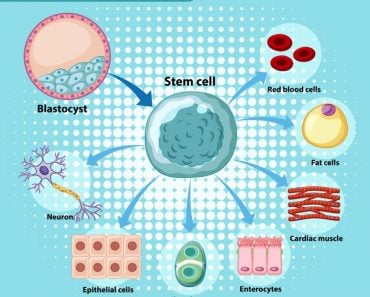Table of Contents (click to expand)
The cells in every human body are constantly in a state of flux. The age of the cells vary, and most of the body completely changes over the course of 10-15 years, although much of the brain remains almost as it was during its inception.
We are biological beings. From our newborn stage to old age, our bodies are constantly changing. Different types of cells make up different organs of our body, and these cells are continuously regenerating as newer cells replace the old ones.

This has invoked philosophical thought experiments that question the nature of individual identity. You may have heard the common saying that our body completely replaces every cell and changes into a completely new one every 7 years. If that’s the case, are you the same person as you were 7 years ago? Or is that someone else? What about the one in the future… will that also be you? Or is that a separate individual?
I, for one, feel like the same person I have always been when I look back on a fundamental level. However, this is a tricky scenario, so let’s see if the claim of our body completely regenerating in 7 years holds true and perhaps get to know our identities a little better.
Recommended Video for you:
The Birth Of A Cell
For the body to be fully functioning, old cells die and new cells are made. One of the ways new cells come about is through the process of mitosis. In the cell cycle, mitosis is where two new nuclei come about from the separation of replicated chromosomes. The process of mitosis is itself divided into various stages; namely prophase, pro-metaphase, metaphase, anaphase and telophase. Each stage is a progression of the division of a parent chromosome that results in two daughter cells, which are copies of the original cell.

The other process of acquiring new cells is through stem cells. Stem cells divide over and over to produce different types of specialized cells required in the body. They also produce new stem cells, which further the process of making new cells. There are three types of stem cells. Embryonic stem cells are responsible for supplying new cells for an embryo as it is developing. They are said to be pluripotent, meaning that they can change into any type of cell the body requires. Adult stem cells are responsible for providing a constant supply of new cells for a developing adult. These cells are multipotent and can only change into some types of cells that the body requires. Induced pluripotent stem cells are those made in the laboratory. They are made by reprogramming cells from the skin and other areas that can be changed into any cell the body requires.

How Do We Know The Age Of The Cells In Our Body?
While trying to determine whether the cortex of our brains ever produces new cells, Dr. Jonas Frisen, a stem cell biologist at the Karolinska Institute in Stockholm, had to find a new way to date the age of cells. The techniques at hand would require tagging DNA with chemicals, but that wasn’t nearly a perfect process.
Dr. Frisen had to think of a natural tag with which he could deduce the age of the cells. He recalled that nuclear weapons were tested aboveground until 1963, and these tests had injected radioactive carbon-14 into the atmosphere. This carbon-14 enters the DNA of cells as plants breathe it and animals and people eat it in their food. This DNA is duplicated each time a cell divides. The DNA in any cell is never replaced, although most of the molecules themselves are replaced. Thus, a new cell acquires its DNA as it is formed, including the carbon-14 that got naturally tagged. Dr. Frisen realized that the enrichment of this carbon-14 tag on the DNA could be used to estimate the age of the cell.
Dr. Frisen used tissues instead of cells to determine the age, as a cell contains very little carbon-14 for dating. This technique was then used to determine the age of various cells in the organs of a human body.
The Real Age Of Our Body
On July 15th,2005, Dr. Frisen and his colleagues issued their findings on the age of various cells in an edition of Cell. They conducted this research with adults in their late 30’s. They found that the cells in the muscles of these adults had an average age of 15.1 years. On the other extreme, the epithelial cells on the surface of the gut have a very short life of just 5 days, on average. That being said, the average age of the cells in the main area of the gut was 15.9 years, on average.
Through other methods, it is known that a red blood cell travels a whopping 300 miles throughout the body and has a life of about 4 months. White blood cells live longer than that, lasting an average of about 1 year. Colon cells have a relatively shorter life of only 4 days; this shorter life is also seen in sperm cells, which last only 3 days. Cells on the skin are constantly changing, as they have to handle the upkeep of an individual and live roughly 2 to 3 weeks. The skeleton of a human could take around 10 years to be completely replaced. A liver takes around 300-500 days to completely renew itself.

Now comes the big question pertaining to our identities: do cells in the brain get completely replaced too? Dr. Frisen and company found that the cells in the visual cortex were exactly the same age as the individual, showing that after birth, no new neurons are generated in the cerebral cortex, at least in numbers that would make a difference. They also found that the cells in the cerebellum of the individual were slightly younger, which gives credence to the idea that development in the cerebellum continues after birth.
The Bottom Line
The cells in every human body are in a constant state of flux throughout the individual’s lifetime. Although almost all the cells die and are consistently replaced, their life cycles vary from different organs, types, and functions. This lifecycle could be as short as 3 days or as long as 16 years!
The thing that makes you the person you are (your brain) doesn’t make new neurons after its inception. The brain where your memories, ideas, beliefs, personality and every other detail of you remains the same throughout your life.
In conclusion, the claim that our body completely changes every 7 years is false. A more nuanced claim would be that most of the body changes every 10-15 years, while some parts of the body remain the same, dying only with the individual.
References (click to expand)
- The Cell Cycle & Mitosis Tutorial - University of Arizona. The University of Arizona
- What Are Stem Cells - Health Encyclopedia - URMC. The University of Rochester Medical Center
- Spalding, K. L., Bhardwaj, R. D., Buchholz, B. A., Druid, H., & Frisén, J. (2005, July). Retrospective Birth Dating of Cells in Humans. Cell. Elsevier BV.
- Limited Test Ban Treaty (LTBT) - 2009—2017 State.gov. United States Department of State












